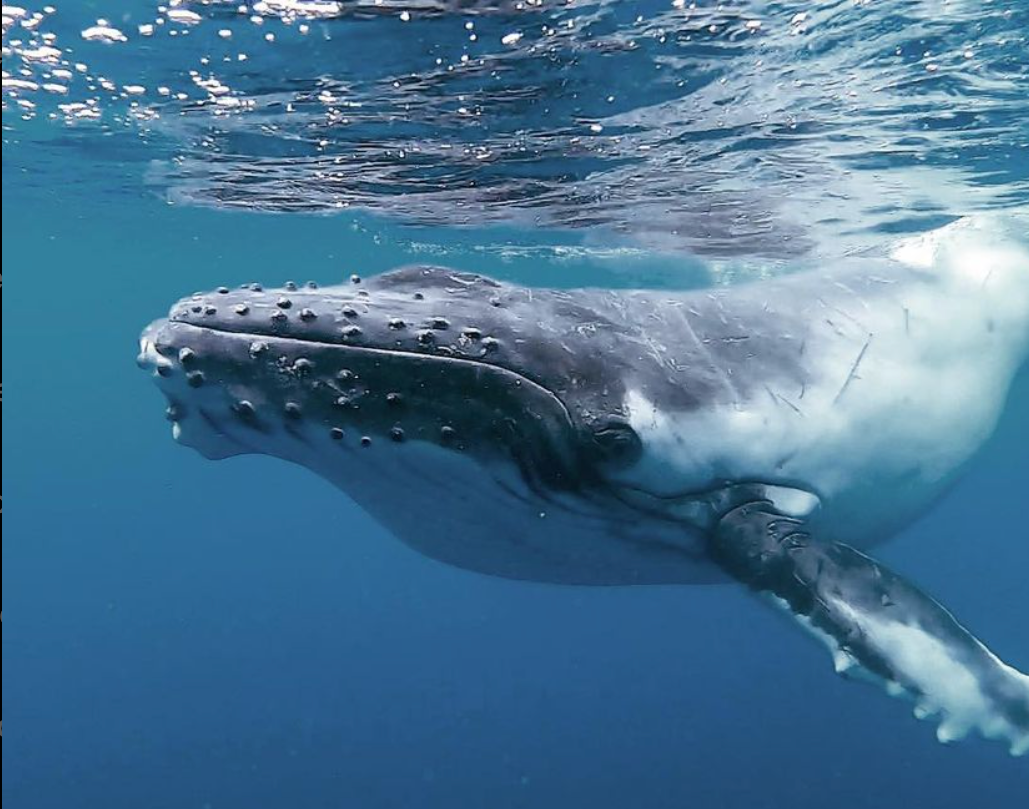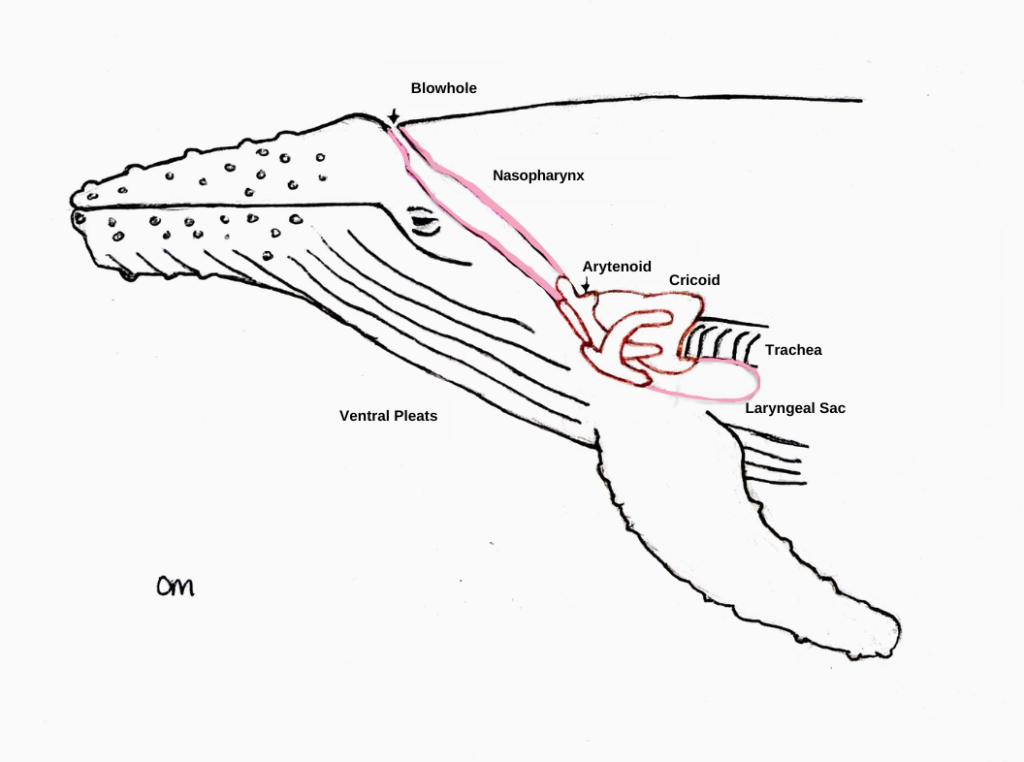The plaintive songs of Megaptera novaeangliae, commonly known as the Humpback Whale, have captured humanity’s attention for decades. The humpback whale (hereafter referred to as HW) is a migratory whale of the suborder mysticeti, or the baleen whales, with comb-like plates to filter food instead of teeth. While scientists have long studied HW song, its function remains elusive. Here, we dive into the vocal behavior of HWs, including hypothesized reasons behind the diverse array of HW song and non-song sounds, mysticeti’s unique respiratory anatomy, and the impacts of human sound on HW behavior.

Image Credit: Lauren Fritz (@thegreenestblue)
Humpback respiratory anatomy
Baleen whales, including HWs, have unique anatomical features that enable them to survive underwater, including a bilateral blowhole, oral [1] and nasal [2] “plugs”, and – not to mention – lungs that can expand to the volume of a small car! Such features support rapid exchange of air at the surface and dives that can last about half an hour.
Baleen whales also developed specialized anatomy for underwater communication during their evolutionary return to sea from land. Like many terrestrial and marine animals, they can produce a wide range of controlled sounds, but they do not have vocal folds that allow them to do this.
Baleen whale larynxes, the organ instrumental in sound production, or phonation, are distinctive among vertebrates. Their larynx includes a U-shaped support structure called the arytenoid cartilage (see the diagram below). The lower half of this cartilage is covered by muscles and moist linings called mucosa [3]. When the whale switches from breathing to phonation, movement of the arytenoid cartilage presses the muscularized folds tightly against a fat-wedge “cushion” inside of a separate cartilage within the larynx (called the cricoid cartilage), which closes the airspace. When air is expelled through this gap, the tissue vibrates – producing sound [3]. Furthermore, an unusual, parallel-to-trachea orientation of the HWs phonatory structures is thought to help them project sound directly into and through surrounding water [4]. HWs also have a laryngeal “air sac” – essentially a big pocket below the larynx – which may help recycle internal air, add resonance frequencies, elongate song, and transmit sounds further [5]. The laryngeal sac is believed to pulse with and thereby extend sound waves through the HW’s characteristic throat grooves (See the diagram below) [6,7].

Non-song sounds
HWs of all age classes and both sexes been recorded making different non-song noises, including physical interactions with water, like slapping and underwater blows, as well as vocalizations such as groans, grunts, cries, snorts, barks, and “th/wops!” (though sound nomenclature varies between studies)[8]. These sounds can be used for coordination of certain behaviors, such as the “trumpet” calls accompanying HWs’ distinctive bubble net feeding, which might serve to stun prey. Another example occurs during bottom feeding, which is often accompanied by vocal “paired bursts” that are thought to help HWs communicate with conspecifics and/or manipulate fish prey [9,10]. HW mothers and calves can use vocalizations in addition to physical touch to stay close during travel, and have been shown to increase the rate (but not volume) of these calls during resting periods relative to traveling periods; during rest, mother and calf have a high likelihood of spatial separation, thereby relying more on subtle sound to locate one another, without simultaneously alerting male conspecifics or possible predators (like orcas) [11]. Traveling baleen pods also apparently use low frequency vocalizations to stay together over longer distances, as low frequency sounds diminish less quickly underwater [12]. Higher frequency sound can be used in closer, private social interaction, such as within mating and competition sites [3]. The rate of sound production has been observed to differ between whale groups that are joining one another and groups that are splitting up, and the suite of all such noises have been termed “social sounds” [13]. HW sound qualities are also thought to communicate an individual’s distinct motivational or arousal state [14]. However, only male HWs are known to “sing”. In contrast to the previously-described vocalizations, HW songs are longer, repetitive, and rhythmic, with patterns that have made them widely known to the public [15].
Humpback whale song
There are many hypotheses about why HW males are known to “sing” [16]. Early interpretations of HW song were influenced by the belief that they occur only when whales convene in low-latitude, tropical seas during the breeding season (winter in the respective hemisphere). However, there have since been increasing observations of male song during migration to summer feeding grounds, and even on the feeding grounds [17].
This has resulted in different classes of hypotheses:
The longstanding hypothesis is that a male’s song is a mating call used to attract females. This pattern is observed in many bird species, so it’s a possible example of the evolution of similar functional solutions in response to similar environments in different animals (also known as convergent evolution). It may be that the duration, amplitude, and/or pitch of a HW male’s song provides some information to females, such as his physical fitness, memory skills, and/or unique song improvisations. In turn, females could have evolved to prefer certain sounds to others due to what they are associated with (e.g. big size or big brain) [18].
Another hypothesis is that song is used for competition between males in the search for mates [16,19]. However, several studies have shown that HW males do not only use songs antagonistically, but to coordinate within small groupings of males that escort a lone female. Males escorting a female within a so-called “competitive group” have been observed to prevent females being escorted away by out-group males, or separating a mother from her calf in order to compel her to mate with the dominant male [18]. Even within a group escorting a female, song may serve to advertise to additional potential mates (humpbacks are polygamous, after all); the commonly-observed head down singing orientation of HW is thought to maximize horizontal transmission of sound [7], supporting a wider broadcast and possible audience.
HW song has also been conceived as a form of sonar or echolocation, similar to what bats do. HWs might use it to identify conspecifics and navigate seascape features while foraging, breeding, and traveling [20]. Perhaps supporting this idea, most singing is nocturnal, when there is reduced ability to rely on visual cues.
Less-frequently investigated hypotheses include that song is merely for pleasure (which is itself an evolutionary function), or that it is an evolutionary relic – a feature that was useful at some point in the evolution of the species, but is no longer essential [18]. Some hypothesize that songs communicate important news or information, and while there are ongoing efforts now to de-code or translate whale song, at present there appears to be more research demonstrating how shorter vocalizations, rather than songs, are used to coordinate in social interactions such as travel and feeding (see above).
Light attenuates quickly underwater, whereas sound travels faster in water than through air, which can help explain the high reliance on sound for underwater animals – due to the ocean’s sensory context, HW song may serve multiple, non-mutually exclusive functions.

Song geography
There are at least 16 distinct populations of HWs throughout the world’s oceans. Between regions, populations’ songs differ – but males generally sing the same song within one population. When groups encounter one another, they change to sing just one song, presumably adapting to whichever is better for the purposes it serves [18]. Changing songs is frequently – but not unanimously – referred to as “cultural transmission”; songs change over time, and new subsections can be incorporated, through possible mechanisms including innovation, memory loss, immigration, adaptation to local conditions, and genetic predispositions [21]. While fragments of songs are changed over time, HWs pick up the song at the beginning of a new breeding season with little change from the last, and a song is entirely replaced within 5-10 years. Juvenile male HWs have been observed singing short phrases at the end of the feeding season, and there is some research showing a correlation between the amount of a song sung, changes in testosterone levels, and changes in environmental cues, such as photoperiod [22].

Human disturbance
Human noise, from vessels, oil and gas exploration, seismic research, and military activity affects HW health and behavior in various ways, including by reducing the ability of HWs and other sea animals to communicate [23,24,25]. For example, human noise may cause the separation of mother and calf pairs who, as aforementioned, rely on sound to locate one another when apart. As human underwater noise increases, HWs increase the amplitude of their communication, but they can’t always keep up – there are physiological limits to the amplitude and frequencies at which a whale can call [3].
In some cetacean species, noise linked to military sonar activities has led to devastating mass stranding events. Scientists have investigated numerous potential mechanisms behind such strandings – including that sound disrupts normal diving patterns, leading to rapid surfacing and tissue nitrogen accumulation (analogous to decompression sickness in divers), that sound-induced disorientation leads whales to navigate to unsafely shallow waters, or that blast damage may lead to hearing damage or loss [26]. Additionally, mid- to -long term disruptions from human noise include stress, meal disturbance, and alteration of breeding, migrating, calling, nursing, and prey behaviors [27,28,29] . Whatever the case, researchers have demonstrated a relationship between the historical onset and modern schedules of high sound testing activities and cetacean mass strandings [30].
In addition to disrupting vital behaviors, fatal accidents such as ship strikes may occur if a whale fails to avoid (or even pursues) a source of human sound. It is possible that ship strikes occur when whales accustomed to a loud ocean have a hard time differentiating between sounds, when whales are otherwise focused on a social activity, or, when they have not yet learned the cues associated with approaching vessels [31].

Conclusion
Sound is a vital part of the seascape for humpback whales, and we know that it serves important communication functions within and between groups. The evolution of distinctive baleen anatomy for sound production and control has supported the development of rich sonic cultures between global humpback whale populations. While certain adverse human impacts on cetacean behavior are clear, in other cases, the effects may be subtle, long-term, or as of yet, imperceptible [27]. Accordingly, while growing research has sought to understand the influence of noise pollution and an ever-busier ocean on humpback behavior, there remain many unknowns regarding the full extent of our impact, meaning that a precautionary approach is warranted as we continue to learn.
Written By: O. Michelle is passionate about marine bioacoustics, and is working with a UCSC research team analyzing whale behavior in Antarctica, and with the National Geographic in science/technology education. O. Michelle has a doctorate in Geography, and is currently an affiliate of the UC Davis Institute of the Environment.
References
[1] Gil, K. N., Vogl, A. W., & Shadwick, R. E. (2022). Anatomical mechanism for protecting the airway in the largest animals on earth. Current Biology, 32(4), 898-903.
[2] Gil, K. N., Lillie, M. A., Vogl, A. W., & Shadwick, R. E. (2020). Rorqual whale nasal plugs: protecting the respiratory tract against water entry and barotrauma. Journal of Experimental Biology, 223(4), jeb219691.
[3] Elemans, C. P., Jiang, W., Jensen, M. H., Pichler, H., Mussman, B. R., Nattestad, J., … & Fitch, W. T. (2024). Evolutionary novelties underlie sound production in baleen whales. Nature, 1-7.
[4] Reidenberg, J. S. (2017). Terrestrial, semiaquatic, and fully aquatic mammal sound production mechanisms. Acoustics Today, 13(2), 35-43.
[5] Reidenberg, J. S. (2018). Where does the air go? Anatomy and functions of the respiratory tract in the humpback whale (Megaptera novaeangliae). Madagascar Conservation & Development, 13(1), 91-100.
[6] Riede, T., Tokuda, I. T., Munger, J. B., & Thomson, S. L. (2008). Mammalian laryngseal air sacs add variability to the vocal tract impedance: Physical and computational modeling. The Journal of the Acoustical Society of America, 124(1), 634-647.
[7] Au, W. W., Pack, A. A., Lammers, M. O., Herman, L. M., Deakos, M. H., & Andrews, K. (2006). Acoustic properties of humpback whale songs. The Journal of the Acoustical Society of America, 120(2), 1103-1110.
[8] Stimpert, A. K., Au, W. W., Parks, S. E., Hurst, T., & Wiley, D. N. (2011). Common humpback whale (Megaptera novaeangliae) sound types for passive acoustic monitoring. The Journal of the Acoustical Society of America, 129(1), 476-482.
[9] Leighton, T., Finfer, D., Grover, E., & White, P. (2007). An acoustical hypothesis for the spiral bubble nets of humpback whales and the implications for whale feeding. Acoustics Bulletin, 22(1), 17-21.
[10] Parks, S. E., Cusano, D. A., Stimpert, A. K., Weinrich, M. T., Friedlaender, A. S., & Wiley, D. N. (2014). Evidence for acoustic communication among bottom foraging humpback whales. Scientific reports, 4(1), 7508.
[11] Indeck, K. L., Girola, E., Torterotot, M., Noad, M. J., & Dunlop, R. A. (2021). Adult female-calf acoustic communication signals in migrating east Australian humpback whales. Bioacoustics, 30(3), 341-365.
[12] Würsig, B. (1988). The behavior of baleen whales. Scientific American, 258(4), 102-107.
[13] Dunlop, R. A., Cato, D. H., & Noad, M. J. (2008). Non‐song acoustic communication in migrating humpback whales (Megaptera novaeangliae). Marine Mammal Science, 24(3), 613-629.
[14] Dunlop, R. A. (2017). Potential motivational information encoded within humpback whale non-song vocal sounds. The Journal of the Acoustical Society of America, 141(3), 2204-2213.
[15] Handel, S., Todd, S. K., & Zoidis, A. M. (2012). Hierarchical and rhythmic organization in the songs of humpback whales (Megaptera novaeangliae). Bioacoustics, 21(2), 141-156.
[16] Herman, L. M. (2017). The multiple functions of male song within the humpback whale (Megaptera novaeangliae) mating system: review, evaluation, and synthesis. Biological Reviews, 92(3), 1795-1818.
[17] Ryan, J. P., Cline, D. E., Joseph, J. E., Margolina, T., Santora, J. A., Kudela, R. M., … & Fischer, M. (2019). Humpback whale song occurrence reflects ecosystem variability in feeding and migratory habitat of the northeast Pacific. PLoS One, 14(9), e0222456.
[18] Parsons, E. C. M., Wright, A. J., & Gore, M. A. (2008). The nature of humpback whale (Megaptera novaeangliae) song. Journal of Marine Animals and Their Ecology, 1(1), 22-31.
[19] Tyarks, S. C., Aniceto, A. S., Ahonen, H., Pedersen, G., & Lindstrøm, U. (2022). Changes in humpback whale song structure and complexity reveal a rapid evolution on a feeding ground in Northern Norway. Frontiers in Marine Science, 9, 862794.
[20] Iii, E. M. (2018). The sonar model for humpback whale song revised. Frontiers in Psychology, 9, 1156.
[21] Mercado, E. (2021). Song morphing by humpback whales: Cultural or epiphenomenal?. Frontiers in Psychology, 11, 574403.
[22] Kowarski, K., Moors-Murphy, H., Maxner, E., & Cerchio, S. (2019). Western North Atlantic humpback whale fall and spring acoustic repertoire: Insight into onset and cessation of singing behavior. The Journal of the Acoustical Society of America, 145(4), 2305-2316.
[23] Erbe, C., Reichmuth, C., Cunningham, K., Lucke, K., & Dooling, R. (2016). Communication masking in marine mammals: A review and research strategy. Marine pollution bulletin, 103(1-2), 15-38.
[24] Blair, H. B., Merchant, N. D., Friedlaender, A. S., Wiley, D. N., & Parks, S. E. (2016). Evidence for ship noise impacts on humpback whale foraging behaviour. Biology letters, 12(8), 20160005.
[25] Rossi-Santos, M. R. (2015). Oil industry and noise pollution in the humpback whale (Megaptera novaeangliae) soundscape ecology of the southwestern Atlantic breeding ground. Journal of Coastal Research, 31(1), 184-195.
[26] Ketten, D. R. (1995). Estimates of blast injury and acoustic trauma zones for marine mammals from underwater explosions. Sensory systems of aquatic mammals, 391-407.
[27] Weilgart, L. S. (2007). A brief review of known effects of noise on marine mammals. International Journal of Comparative Psychology, 20(2).
[28] Cox, T. M., Ragen, T. J., Read, A. J., Vos, E., Baird, R. W., Balcomb, K., … & Benner, L. (2005). Understanding the impacts of anthropogenic sound on beaked whales. J. Cetacean Res. Manage., 7(3), 177-187.
[29] Weilgart, L. S. (2007). The impacts of anthropogenic ocean noise on cetaceans and implications for management. Canadian journal of zoology, 85(11), 1091-1116.
[30] D’Amico, A., Gisiner, R. C., Ketten, D. R., Hammock, J. A., Johnson, C., Tyack, P. L., & Mead, J. (2009). Beaked whale strandings and naval exercises. Aquatic Mammals, 35(4), 452-472.
[31] Szesciorka, A. R., Allen, A. N., Calambokidis, J., Fahlbusch, J., McKenna, M. F., & Southall, B. (2019). A case study of a near vessel strike of a blue whale: perceptual cues and fine-scale aspects of behavioral avoidance. Frontiers in Marine Science, 6, 761.
[Edited by Alice Michel]